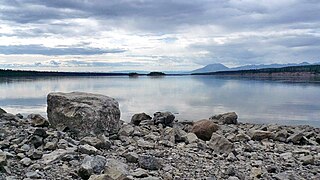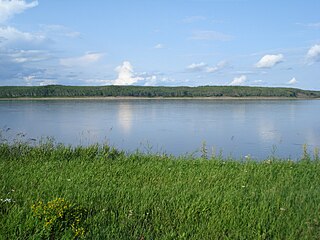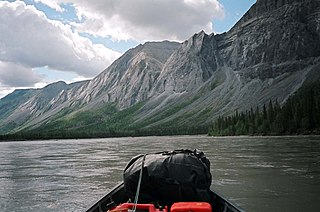Related Research Articles

The Northwest Territories is a federal territory of Canada. At a land area of approximately 1,127,711.92 km2 (435,412.01 sq mi) and a 2021 census population of 41,070, it is the second-largest and the most populous of the three territories in Northern Canada. Its estimated population as of the second quarter of 2024 is 44,920. Yellowknife is the capital, most populous community, and only city in the territory; its population was 20,340 as of the 2021 census. It became the territorial capital in 1967, following recommendations by the Carrothers Commission.

The Slavey are a First Nations group of Indigenous peoples in Canada. They speak the Slavey language, a part of the Athabaskan languages. Part of the Dene people, their homelands are in the Great Slave Lake region, in Canada's Northwest Territories, northeastern British Columbia, and northwestern Alberta.

Nahanni National Park Reserve in the Dehcho Region of the Northwest Territories, Canada, approximately 500 km (311 mi) west of Yellowknife, protects a portion of the Mackenzie Mountains Natural Region. The centrepiece of the park is the South Nahanni River. Four noteworthy canyons reaching 1,000 m (3,300 ft) in depth, called First, Second, Third and Fourth Canyon, line its whitewater river. The name Nahanni comes from the indigenous Dene language name for the area; Nahʔa Dehé, which means "river of the land of the Nahʔa people". The park was among the world's first four natural heritage locations to be inscribed as World Heritage Sites by UNESCO in 1978 because of its picturesque wild rivers, canyons, and waterfalls.

The Liard River of the North American boreal forest flows through Yukon, British Columbia and the Northwest Territories, Canada. Rising in the Saint Cyr Range of the Pelly Mountains in southeastern Yukon, it flows 1,115 km (693 mi) southeast through British Columbia, marking the northern end of the Rocky Mountains and then curving northeast back into Yukon and Northwest Territories, draining into the Mackenzie River at Fort Simpson, Northwest Territories. The river drains approximately 277,100 km2 (107,000 sq mi) of boreal forest and muskeg.

Mount Nirvana, at 2,773 m (9,098 ft) is the unofficial name of the highest mountain in the Northwest Territories, Canada. Currently the Canadian government is working to officially recognize the name Thunder Mountain, reflecting the local Dehcho First Nation name for the mountain. Today, the name Mt. Nirvana is commonly depicted in alpine literature.

The Mackenzie Mountains are a Canadian mountain range forming part of the Yukon-Northwest Territories boundary between the Liard and Peel rivers. The range is named in honour of Canada's second prime minister, Alexander Mackenzie. Nahanni National Park Reserve and Nááts'ihch'oh National Park Reserve are in the Mackenzie Mountains.
Nahanni Butte Water Aerodrome(TC LID: CET8) was adjacent to the community on the South Nahanni River and was open seasonally from the middle of June until October. It was located near Nahanni Butte, Northwest Territories, Canada, east of the Nahanni National Park Reserve, on an arm of the South Nahanni River.

Nahanni Butte is a "Designated Authority" in the Dehcho Region of the Northwest Territories, Canada. The community is located at the confluence of the Liard and South Nahanni Rivers in the southwestern part of the NWT.

The South Nahanni River is a major tributary of the Liard River, located roughly 500 km (310 mi) west of Yellowknife in the Northwest Territories of Canada. It is the centerpiece of Nahanni National Park Reserve. It flows from the Mackenzie Mountains in the west, through the Selwyn Mountains, growing as it heads east over the majestic Virginia Falls, and finally empties into the Liard River. The Nahanni has a unique geological history. It was formed when the area was a broad flat plain, forming a winding course typical of flatland rivers. As the mountains lifted, the river cut four deep canyons into the rock, maintaining its eccentric course.

Virginia Falls is a waterfall in Nahanni National Park Reserve, Northwest Territories, Canada. It is on the South Nahanni River, at an elevation of 500 m (1,600 ft). It is located 120 km (75 mi) from the Yukon border.

The Taiga Plain Ecozone, as defined by the Commission for Environmental Cooperation (CEC), is a Canadian terrestrial ecozone that covers most of the western Northwest Territories, extending to northwest Alberta, northeast British Columbia and slightly overlapping northeastern Yukon.

The Taiga Cordillera Ecozone, as defined by the Commission for Environmental Cooperation (CEC), is a rugged, mountainous terrestrial ecozone of Canada spanning most of northern Yukon and significant portions of the border between the Yukon and the Northwest Territories.

Náátsʼihchʼoh National Park Reserve is a Canadian national park reserve, located in the Northwest Territories and encompassing areas of the South Nahanni River watershed. The name means "stands like a porcupine" in the Dene language. The national park reserve covers an area of 4,850 km2 (1,873 sq mi), protecting the Sahtú Settlement Area of the upper South Nahanni watershed, which adjoins with Nahanni National Park Reserve; the two adjacent areas are, however, managed separately.
Cirque of the Unclimbables, located inside the Nahanni National Park Reserve, in the Northwest Territories, Canada, approximately 500 km (311 mi) west of Yellowknife, is a cluster of peaks and walls in the Mackenzie Mountains Natural Region.

North Nahanni River is a river in the Northwest Territories of Canada. It is a major tributary of the Mackenzie River.
Nahanni is a 1962 short documentary from the National Film Board of Canada directed by Donald Wilder.
Nahanni National Park Reserve is in the Northwest Territories, Canada.
Rabbitkettle Hot Springs is a naturally occurring hot spring located in the Northwest Territories of Canada. The springs are found in the Nahanni National Park Reserve, along the South Nahanni River. Rabbitkettle Hot Springs are situated on a limestone plateau and comprise two large travertine mounds. At 20 metres (66 ft) high and 70 m (230 ft) in diameter, the free-standing North Mound is the largest travertine mound in Canada. The South Mound has grown into a nearby hillside and is not as tall. They are the only tufa mounds in the world known to be located on permafrost. The mounds are multi-colored and tiered.
References
- 1 2 3 Garnet, Basque (2000). Lost Bonanzas of Western Canada. Heritage House.
- ↑ Wendt Ron (2002), Haunted Alaska: Ghost Stories from the Far North. Epicenter Press
- ↑ "Parks Canada - Cultural Heritage". Parks Canada. August 2008. Archived from the original on 2005-02-14. Retrieved 2010-01-12.